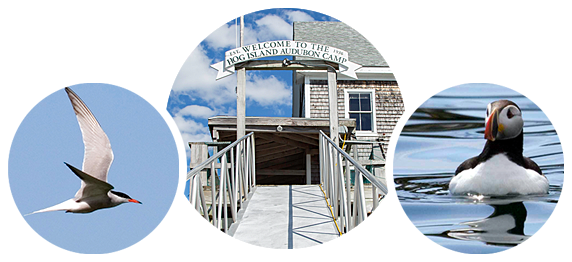By Ada Graham and Frank Graham, Jr.
When we moved to Maine in 1961 we were already members of the National Audubon Society and eager to explore the natural areas around us. But what were the living components of the marshes and mudflats? What were the names of their inhabitants? How did they behave individually? How did they relate with other species to build complex ecosystems? Our chance to find some answers came when we learned about Hog Island.
Farida led us to a “secret cave,” where in the dim light for the first time in our lives we gazed with wonder on a patch of luminous moss.
Signing up in the summer of 1964 at the Audubon Camp in Maine (the installation has changed its name, though never its basic mission), we discovered right away that it was a serious place. The camp offered two-week sessions in those days, and we left the island during that period only on field trips. Bart and Ginny Cadbury ran a tight ship. Meals, boat trips, hikes, labs, evening programs came and went as precisely as Muscongus Bay’s tides.
We still look back with pleasure on the staff that summer. Joe Cadbury was our leader on birding trips. His mnemonic devices for remembering the calls and songs of birds still remain with us. The goldfinch may seem to say one thing or another depending on the listener, but we know that in flight it clearly says “Potato-chip?”
Farida Wiley was our botanical oracle. Thousands of people must have followed her on morning nature walks into New York Central Park during the many years she was on the staff of the American Museum of Natural History, but we had her to ourselves on Hog Island for two full weeks. A part of our time then was spent guessing the nature of the treasures that she promised to show us before we left. Finally the momentous day arrived: Farida led us to a “secret cave,” where in the dim light for the first time in our lives we gazed with wonder on a patch of luminous moss. (Was it Schistostega osmundacea, Bart?)
And there was a young storekeeper at the camp that summer, a high school student named Hank Tyler who had an extraordinary gift for natural history. Afterward, when Hank found himself a seasonal position at the little museum on Grand Manan, he would stop and see us on his way to that magical island and help us figure out the identify of some plant that had us stumped. We have always been proud of Hank’s rise as one of Maine’s most eminent biologists and conservationists.
The lessons we took away from Hog Island truly determined our future. For some years we volunteered to run a summer nature program for the children in our community — those kids affirm to this day that the goldfinch DOES say, “potato-chip.” From that experience was to come the series of children’s books we wrote during the 1970’s and 1980’s. Meanwhile our ties to National Audubon grew and we both served for many years on the Audubon staff, one of us with the magazine and the other with the Audubon Adventures program.
A patch of luminous moss is only part of the glow we catch sight of when we look back on that summer of ’64.

